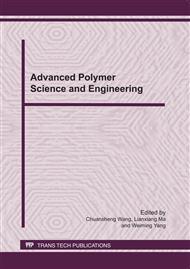p.283
p.289
p.295
p.302
p.308
p.316
p.321
p.326
p.333
Preparation of Antibacterial Cotton Fabric Containing Patchouli Oil Microcapsules by Chemical Crosslinking Method
Abstract:
In this paper, a new kind of antibacterial cotton fabric containing patchouli oil microcapsules was investigated. The patchouli oil microcapsules were prepared using a complex coacervation procedure and grafted onto cotton fabric by chemical crosslinking method, along with 1,2,3,4-butanetetracarboxylic acid (BTCA) was utilized as the crosslinking agent. The surface and morphology of fabrics were characterized by using scanning electron microscope (SEM). Fourier transform infrared spectrometry (FTIR) was used to study the formation of ester bonds between BTCA and hydroxyl groups of cotton and patchouli oil microcapsules. The releasing characteristics and antimicrobial durability of the antibacterial fabrics were also investigated by releasing test and laundering test. The results showed that the patchouli oil microcapsules were grafted onto cotton fabric by the role of crosslinking agent BTCA and the treated fabric represented persistent effect, slow releasing performance and washable antibacterial properties. After 30 days, the patchouli oil in the microcapsules was still remained on the fabric and the releasing amount was near 50%. About 72% antibacterial rate of the fabric for staphylococcus aureus and candida albicans could be obtained after washed 30 times, furthermore, no formaldehyde releasing can be found. It is suggested that chemical crosslinking method would provide a potential application in functional finishing by microcapsules for cotton fabric.
Info:
Periodical:
Pages:
308-315
Citation:
Online since:
March 2011
Authors:
Keywords:
Price:
Сopyright:
© 2011 Trans Tech Publications Ltd. All Rights Reserved
Share:
Citation:


